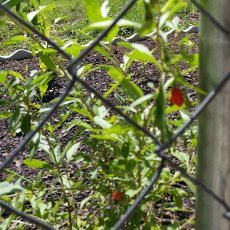
I eat some goji berries every day. Why? Because it is at the top of my list as a superfood AND as an adaptogen. Yes, you heard that right! Both! And if you have read my article on adaptogens, then you have to believe that these little berries have to be great for your health.
Goji berries are the fruit of the plants known by their botanical (Latin) names as Lycium chinense and Lycium barbarum. Lycium is what the modern day herbalist calls the goji berry. So both terms will be used, goji berries as a superfood and Lycium as an adaptogen.
You may have first been made aware of goji berries when you went into a health food store and saw the refrigerated individual bottled drinks that were very expensive. And I mean expensive! Goji berries is one of those foods that have gotten a lot of hype in the past decade or so. Turns out that a lot of hype means they get to be expensive.
I have to confess that I was not willing to promote goji berries at first. I remember when I had just opened up my herb shop business in 2011, I went into a restaurant where I was to attend a Health Council meeting for the county I live in. A gentleman who was also attending the meeting, stopped me to ask if I was going to carry goji berries in my herb shop. As I think back, I realize that I was quite adamant that I would NOT. My reasoning was that I should focus on using the herbs that are local or at least were from this country. I firmly believe the old herbalist adage that any herb we may need is in our own back yard. But now I not only eat goji berries everyday, but I also sold goji berries for a few years until my local shop and online store - now called Thyme's Tinctures Store - focused on selling just my handmade tinctures instead. So what made me change my mind?
Turns out goji berries (also known as wolfberry, boxthorn, matrimony vine, desert thorn) grow in the USA! In fact, there are fifteen species of Lycium in North and Central America, which share the same benefits as the Asian species. The species growing in the US are mostly in the desert Southwest. Goji berries were a staple for the Native Americans.
One of the Chinese species Lycium barbarum was imported into England in 1730 and grows wild as hedgerows in the coastal areas. So that illustrates how Lycium can grow about any where. From what I understand it will grow best if it has to struggle, which is typical of adaptogens.
With all its benefits and that it can grow locally, I had to include it among my herbs.
So what are the benefits of goji berries, aka Lycium? Let's start defining those benefits by looking at why goji berries is even considered a superfood. Superfoods are nutrient dense, where nutrient dense means these foods are superior sources of essential nutrients and antioxidants.
You may recall that essential nutrients are nutrients we must get from food. So do goji berries give us essential nutrients? You bet! Goji berries gives us all eight essential amino acids, just like meat, fish and dairy does. So it is considered a complete protein by some. (Protein is made up of chains of amino acids). Although technically a complete protein has the 8 essential amino acids AND the correct proportion of the other 12 amino acids that the human body uses to make protein. Goji berries have only 18 amino acids, so in that sense, they are not a complete protein. BUT, for a fruit that has the essential amino acids, Goji berries are still a superior source of essential nutrients.
Now for the second part, antioxidants. Goji berries are clearly a superior antioxidant. Nutritionfacts.org provides an excellent brief video of the graph comparing the ranking of the top antioxidants. Goji berries are ranked fifth of all known antioxidant foods. As comparison, blueberries rank 37. Clearly gogi berries is a superfood!
What makes Lycium an adaptogen? Referring back to my article on adaptogens, there are three requirements.
First, it must not be toxic. Well, that one is easy to meet, since Lycium has been a food for a long time and has been extensively tested to prove that it is completely nontoxic.
Second, it must demonstrate an increase in the power of resistance against multiple stressors including physical, chemical, or biological agents. Research has shown the Lycium increases white blood cells, including lymphocytes, and has also been shown to increase interleukin-2, all which helps one going through cancer treatment. With high antioxidant capability, Lycium can accelerate DNA repair of aging cells. Another study showed Lycium enhances immune responses. From another study researchers concluded that Lycium significantly decreased the oxidative stress caused by exercising to exhaustion.
Third, it must have a normalizing influence. Lycium is very effective in treating age-related eye disorders like macular degeneration and cataracts. Lycium helps with weight loss. Lycium has anti-inflammatory and neuro-protective properties. Lycium also treats sexual dysfunction by increasing Human Growth Hormone (only food known to have this capability) which in turn facilitates increasing testosterone. Lycium lowers the levels of the small dense cholesterol (the REAL bad cholesterol). Lycium protects DNA, increases choline production in the liver, calms the nervous system, enhances memory, promotes muscle growth, and protects the liver by preventing fatty liver disease and detoxifying the liver.
An excellent article whose title is Secrets of Longevity discusses how goji berries (Lycium) increases longevity. In other words, goji berries are anti-aging. Make sure to go to the last part of the article to learn how to grow your own goji berries. Who knew it is so easy to do? And I can vouch for it. The goji berry plants I have are doing quite well. They love to climb, so I planted them along my garden table bed pen with a solar powered blinking red LED "eye" nearby to discourage deer eating the berries at night.

Bottom line, whether you call them Lycium or goji berries, they definitely meet the requirements for being BOTH a superfood and an adaptogen. And that is exactly why I eat them every day.
I resteemed this for you.
You'd probably get more visibility on this post if you used tags like
" health food wellness blog life"
A steemian recently pointed this out to me actually when i was wondering why my posts weren't getting visibility.
Look at the "main " tags... your tags are very specific i don't think many would search for them
Just Saying bevause this is a really good post and deserves that visibility
Thank you for the much needed advice. As you can tell, I am very, very new in Steem. I will check if I can edit the tags.
Oh you're welcome. You can edit them, just not the first one as that's your category
Interesting how our mindsets can change over time. It is hard to buy into the hype on something sold by an over commercialized crazy large company. Well hard for people like you and I anyway. I'm still trying to figure out how to explain to my FIL why vitamin water isn't actually good for you.. .what with the damned sugar content, artificiak flavorings, etc. Hey, i think I'm going to do a blog on it. Hehe. However, i digress. Thanks for this great blog. Cool that lycium actually grows in the US, didn't know that
So agree about the hype. As soon as I read some raving promotion on an herb or food, I check to see if the author/company has a financial interest. If they do, I become skeptical. The more the raving, the more I'm sceptical.
Yea especially since vitamin water is run by the coca cola company!
Wow! So informative. I think I'm going to have to add a goji berry plant to my list of plants to pick up at the nursery. I've got the perfect space in the garden for this one. Glad to be following you! Joining the online communities created around the things you're passionate about is really turning out to reveal some amazingly knowledgeable people (like yourself) that I may not have had access to before.
Whoops! Need to check for replies more often.
My plants have really grown since that photo. Lots of berries now, too. By next year I hope to get enough to dry. Until then I will just let the berries ripen to seeds and fall around the plants so that more plants grow.